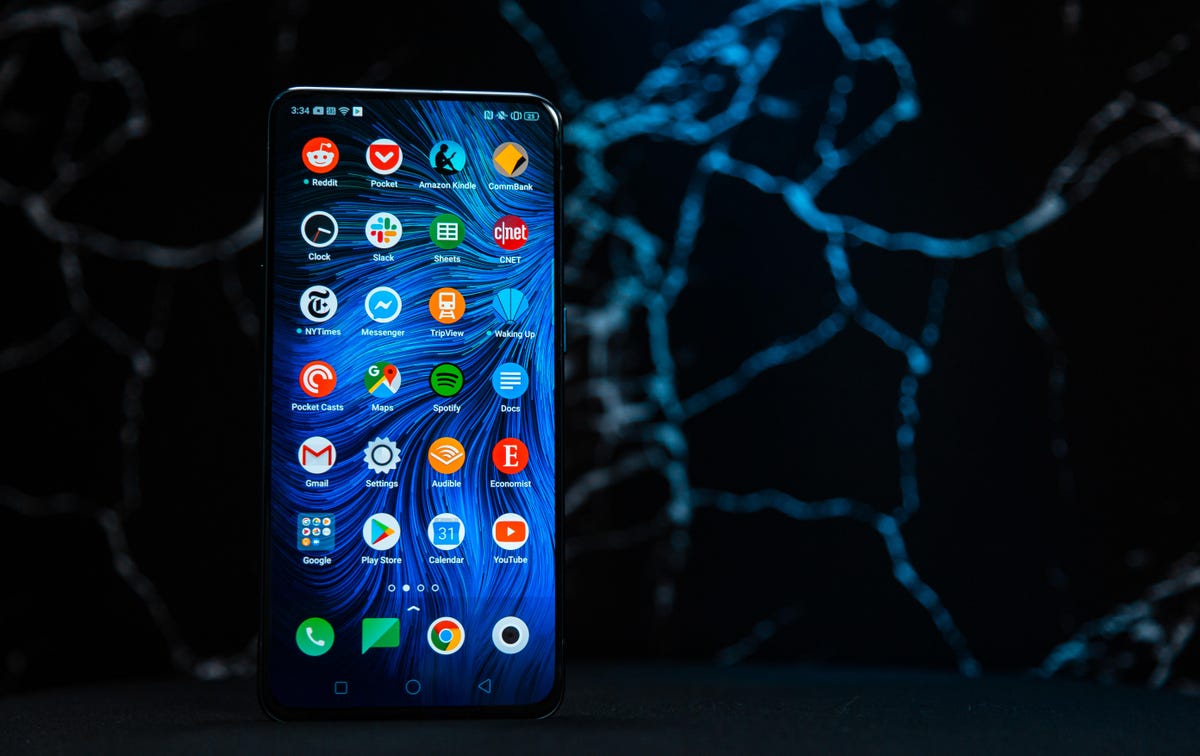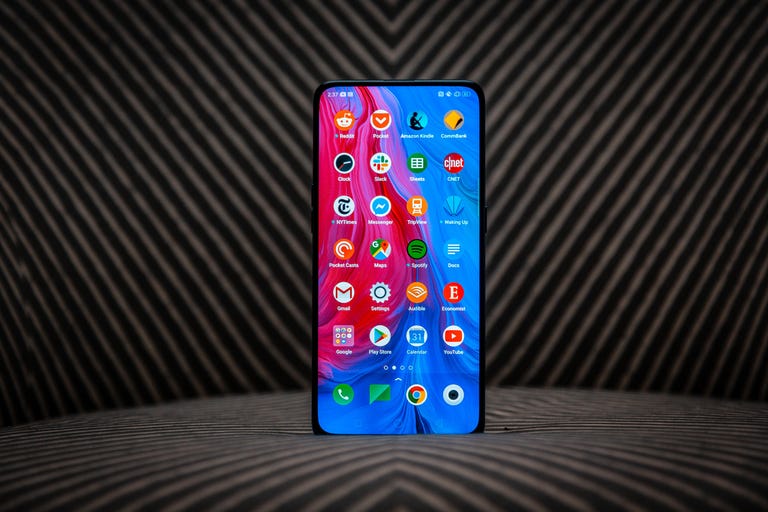 Why You Can Trust CNET
Why You Can Trust CNET Oppo Reno 5G review: The most affordable 5G phone is a winner
With a great pop-up camera, 10x lossless zoom, brilliant screen and decent price, the Reno 5G is a more affordable 5G phone for early adopters.
Editors' note: Oppo just announced its latest flagship phone, the Oppo Find X2 Pro.
The Good
The Bad
The Bottom Line
Carriers around the world, from Sprint and Verizon in the US to Telstra in Australia, have begun offering ultrafast 5G mobile internet, but there are less than a handful of phones that can take advantage of this. The Samsung Galaxy S10 5G and LG V50 are the big ones that can, and OnePlus has also dipped its toes in 5G water. But there's a less-known contender for the 5G crown: the Oppo Reno 5G.
With a standout tri-camera setup, a 1,080x2,340-pixel 6.6-inch display and the fastest processor currently on the market, the Reno 5G is a fantastic phone, with or without 5G. It's also the most affordable 5G phone you can buy. It's not officially available in the US, but its Australian price of AU$1,499 converts to $1,030. In the UK it's sold exclusively via monthly plans through EE, from £49.
That converted price of $1,030 is cheaper than both the $1,152 V50 and the $1,300 S10 5G. The OnePlus 7 Pro 5G is only available in the UK through EE, where plans start at a more pricey £59.

The 6.6-inch Oppo Reno 5G.
But there are two downsides. Oppo's take on Android, ColorOS, has always been weak. But now that it's operating in the same price category as Apple and Google , that's much harder to forgive. Then there's 5G. At this point, buying a 5G phone is an investment for the 2020s, not something you'll immediately be able to take meaningful advantage of.
Luckily, the Oppo Reno 5G has a 4G version -- the Reno 10x Zoom. The 10x Zoom has all of the Reno 5G's specs, minus 5G, and costs AU$1,199 ($835). It's available in the UK for £699, which for Americans is a more expensive import at $885. There's also a base model, the Oppo Reno, with a smaller display, dual cameras and a weaker processor. It's not available in Australia, and at £449 ($570) is more of a Reno Lite.
However, if you're willing to wait for 5G to become and just want a sub-$1,000 phone, the $825 Oppo Reno 10x Zoom is easy to recommend.
Oppo Reno 5G is only as good as its network
The selling point of the Oppo Reno 5G, as the name suggests, is 5G connectivity. A successor to 4G, 5G is the much-hyped mobile internet standard of tomorrow. Thanks to vastly decreased latency and vastly increased speeds, it promises to bring us driverless cars, a new era of smart devices and incomprehensibly snappy download speeds.
But that's all a few years off.
For now, 5G phones connect you to a promising-but-nascent world. Testing the Reno 5G in Sydney, Australia, I was able to get download speeds of up to 489Mbps in the Speedtest.net app. That's 13 times faster than Australia's average 4G speeds and about 5 times faster than our (notoriously bad) broadband internet, but below the 1Gbps-plus speeds that have been demoed by local carriers and way below the 20Gbps-plus speeds that 5G eventually promises.
Using the Reno 5G, I was able to download PUBG (2.04GB) from the Google Play Store in 81 seconds. Wunderbar! For comparison, it takes 5 minutes and 55 seconds using my Wi-Fi at home, which is the fastest plan available in Australia, and just over 3 minutes on 4G. But coverage is limited at the moment. We only have one carrier, Telstra, that offers 5G connectivity, and it's only available in splotches on Sydney's map. Between Sprint , Verizon and EE, the situation is the same in the US and UK.
There will be many who flock to 5G phones out of early-adopter enthusiasm. That's fine, but it's hard to recommend the average person pay extra for a 5G phone right now. The technology is exciting, but very much a work in progress.
Premium processor means more power and battery
Oppo's flagship phones have historically sold for a midrange price, with good-enough processors and cameras that punched above their weight. The Reno isn't like that. The Reno 5G and 10x Zoom are premium from top to bottom.
First, the design. There's no notch here, with the front camera popping up atop the 6.6-inch like a shark fin when you switch to selfie view or put on the flashlight. From the front it looks similar to the OnePlus 7, but it's got a distinct, two-tone backside through which its tri-camera setup runs.
There are also welcome premium touches, like an alacritous in-screen fingerprint reader and a snappy facial scanner. However, the shark fin popup means no headphone jack and no water resistance nor splash resistance. Nada.
Second, the power. Both Reno phones run Qualcomm's Snapdragon 855, 8GB of RAM and an Adreno 640. This means three things: Tremendous speed, the ability to handle any 3D game you throw at it and a terrific battery life. In our battery test, which involves looping a HD video until the battery runs flat, the Reno 5G lasted just over 19 hours, a stellar result. After a full day of work and travel, I'd usually end up with between 30 and 40% juice.
Finally, the photography. The tri-camera system is comprised of a 48 megapixel main camera, a 13 megapixel periscope lens that allows for 5x optical zoom and 10x hybrid (and 60x digital), and an 8 megapixel ultrawide shooter.
Oppo Reno 5G vs iPhone XS Max.
Oppo Reno 5G versus Huawei P30 Pro. The Reno shot is a touch low on contrast here, but I personally prefer it to the artificially-sharpened look of the Huawei P30 Pro.
The Reno 5G camera sometimes struggles with sunny conditions, as you can see here compared to the iPhone XS Max.
But the Reno usually takes excellent day-time photos, like this one of my very old dog.
No night mode.
Night mode.
Here's the Huawei P30 Pro's night mode. The P30 Pro's night mode is better, mostly due to the Reno 5G camera's tendency of overexposure.
I love the camera on the Reno 5G. Its colors are natural and photos don't seem heavily filtered. (That's one gripe I have with Huawei cameras, although many people do prefer the artificially-sharpened look.)
The 5x and 10x zoom features are technically impressive, but I question how much the average person will take advantage of them. The ultrawide camera, though more distorting than the P30 Pro's, is super useful. Like the P30 phones and the Pixel 3 range, the Reno 5G has a Night Mode that uses both soft- and hardware to brighten up lowlight shots.
I compared the Reno 5G to the iPhone XS, my personal favorite for daytime photos, and Huawei's P30 Pro, which after Game of Thrones season 8 is our new Night King. One common problem during both day and night, as you can see in comparisons, was overexposure. But beyond that, I found the Reno 5G to be a close match to the iPhone's color and detail by day and the P30 Pro by night. That makes it a terrific all-rounder, though not a best-in-class.
1x zoom, 6x zoom and 10x zoom.
That sinking feeling
No phones have better software than the iPhone XS' iOS 12 or Google's pure-Android Pie Pixel 3. The 5G variant of the Oppo Reno costs more than both of those phones. That means the company needs to have an operating system to compete. It doesn't.
ColorOS 6, Oppo's take on Android 9.0 Pie, has its nice touches. There's a small, handy shortcut box on the top right of the display that you can pull out with the swipe of a finger. It comes with a Game Space app that optimizes performance for those among us who care about every frame. But it feels like a B-grade OS.
One bewildering example: One of the phone's selling points is its 5x optical zoom. But when you open the (clearly iOS inspired) camera app, tapping the zoom button takes you from 1x to 2x to 6x. So if you want 5x magnification, you either pinch-zoom manually or press up to 6x zoom and scale back.
The tri-camera setup.
Most of my gripes were cosmetic rather than functional. Some of the app notification icons atop the display look copy-and-pasted from Microsoft Paint. Many of the default icons and screen savers look amateurish when compared to other user interfaces. There are easy fixes to a lot of these issues, but buying a phone in this price range is buying an experience just as much as hardware. Graceless design elements end up sullying the user experience -- a small problem in the grand scheme, but noteworthy at this price point.
But the Reno 5G is still a fantastic phone. I can't recommend 5G right now, but if you are desperate to be an early adopter the Reno 5G is the cheapest way to go about it. For everyone else, the 10x Zoom is a much better deal.
Oppo Reno 5G vs LG V50 vs Samsung Galaxy S10 5G vs OnePlus 7 Pro 5G
| Oppo Reno 5G | LG V50 ThinQ | Samsung Galaxy S10 5G | OnePlus 7 Pro | ||
| Display size, resolution | 6.6-inch AMOLED; 1,080x2,340 pixels | 6.4-inch OLED; 3,120x1,440 pixels | 6.7-inch AMOLED | 6.67-inch AMOLED; 3,120x1,440-pixels | |
| Pixel density | 390ppi | 564ppi | 505ppi | 516ppi | |
| Dimensions (Inches) | 6.38x3.04x0.37 in | 6.26x3.0x0.33 in | 6.40x3.04x0.31 in | 6.4x2.99x0.35 in | |
| Dimensions (Millimeters) | 162x77.2x9.3 mm | 159.1x76.1x8.3 mm | 162.6x77.1x7.94 mm | 162.6x75.9x8.8 mm | |
| Weight (Ounces, Grams) | 215g; 7.58 oz | 6.46 oz.; 183g | 6.98 oz.; 198g | 7.27 oz; 206g | |
| Mobile software | Android 9.0 with ColorOS 6 | Android 9.0 | Android 9.0 with Samsung One UI | Android 9.0 with OxygenOS | |
| Camera | 48-megapixel (standard), 13-megapixel (periscope), 8-megapixel (ultrawide) | 12-megapixel (standard), 16-megapixel (wide-angle), 12-megapixel (telephoto) | 12-megapixel (wide-angle), 16-megapixel (ultra wide-angle), 12-megapixel (telephoto), 3D depth (HQVGA) | 48-megapixel (standard), 8-megapixel (telephoto), 16-megapixel (ultra wide-angle) | |
| Front-facing camera | 16-megapixel | 8-megapixel (standard), 5-megapixel (wide) | 10-megapixel, 3D depth (HQVGA) | 16-megapixel | |
| Video capture | 4K | 4K | 4K | 4K | |
| Processor | Octa-core Qualcomm Snapdragon 855 | Qualcomm Snapdragon 855 | Octa-core Qualcomm Snapdragon 855 | Octa-core Qualcomm Snapdragon 855 | |
| Storage | 256GB | 128GB | 256GB | 128GB, 256GB | |
| RAM | 8GB | 6GB | 8GB | 6GB, 8GB, 12GB | |
| Expandable storage | Up to 256GB | 2TB | No | No | |
| Battery | 4,065 mAh | 4,000 mAh | 4,500 mAh | 4,000 mAh | |
| Fingerprint sensor | In-screen | Back | In-screen (ultrasonic) | In-screen (optical) | |
| Connector | USB-C | USB-C | USB-C | USB-C | |
| Headphone jack | No | Yes | TBA | No | |
| Special features | 5G connetivity; shark fin selfie camera, VOOC fast charge, dual-sim, night mode | 5G connectivity; water resistant (IP68); wireless charging, Quick Charge 3.0 | 5G connectivity, Wireless PowerShare; 3D depth cameras (not for face unlock); water resistant (IP68); Fast Wireless Charging 2.0 | 5G connectivity,90Hz display, pop-up selfie camera, dual-SIM, Warp Charging | |
| Price off-contract (USD) | Converted: $1,030 | $1,152 (Sprint) | $1,300 (Verizon) | TBA | |
| Price (GBP) | Converted: £825 | TBA | TBA | TBA | |
| Price (AUD) | AU$1,499 | TBA | TBA | TBA |


